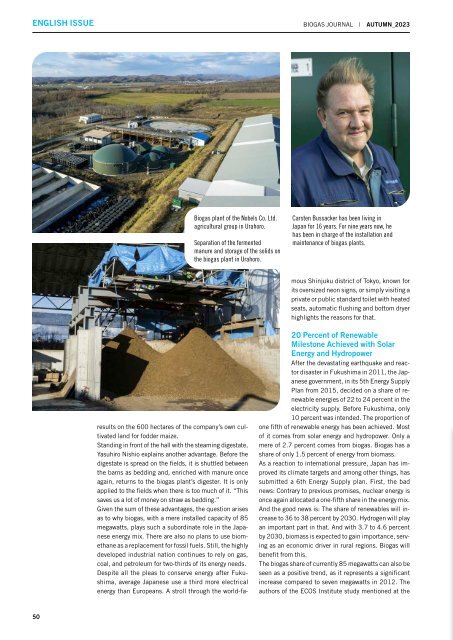Autumn 2023 EN
The German Biogas Association presents its autumn 2023 issue of the English BIOGAS journal.
The German Biogas Association presents its autumn 2023 issue of the English BIOGAS journal.
- No tags were found...
Create successful ePaper yourself
Turn your PDF publications into a flip-book with our unique Google optimized e-Paper software.
<strong>EN</strong>GLISH ISSUE<br />
BIOGAS JOURNAL | AUTUMN_<strong>2023</strong><br />
Biogas plant of the Nobels Co. Ltd.<br />
agricultural group in Urahoro.<br />
Separation of the fermented<br />
manure and storage of the solids on<br />
the biogas plant in Urahoro.<br />
Carsten Bussacker has been living in<br />
Japan for 16 years. For nine years now, he<br />
has been in charge of the installation and<br />
maintenance of biogas plants.<br />
results on the 600 hectares of the company’s own cultivated<br />
land for fodder maize.<br />
Standing in front of the hall with the steaming digestate,<br />
Yasuhiro Nishio explains another advantage. Before the<br />
digestate is spread on the fields, it is shuttled between<br />
the barns as bedding and, enriched with manure once<br />
again, returns to the biogas plant’s digester. It is only<br />
applied to the fields when there is too much of it. “This<br />
saves us a lot of money on straw as bedding.”<br />
Given the sum of these advantages, the question arises<br />
as to why biogas, with a mere installed capacity of 85<br />
megawatts, plays such a subordinate role in the Japanese<br />
energy mix. There are also no plans to use biomethane<br />
as a replacement for fossil fuels. Still, the highly<br />
developed industrial nation continues to rely on gas,<br />
coal, and petroleum for two-thirds of its energy needs.<br />
Despite all the pleas to conserve energy after Fukushima,<br />
average Japanese use a third more electrical<br />
energy than Europeans. A stroll through the world-famous<br />
Shinjuku district of Tokyo, known for<br />
its oversized neon signs, or simply visiting a<br />
private or public standard toilet with heated<br />
seats, automatic flushing and bottom dryer<br />
highlights the reasons for that.<br />
20 Percent of Renewable<br />
Milestone Achieved with Solar<br />
Energy and Hydropower<br />
After the devastating earthquake and reactor<br />
disaster in Fukushima in 2011, the Japanese<br />
government, in its 5th Energy Supply<br />
Plan from 2015, decided on a share of renewable<br />
energies of 22 to 24 percent in the<br />
electricity supply. Before Fukushima, only<br />
10 percent was intended. The proportion of<br />
one fifth of renewable energy has been achieved. Most<br />
of it comes from solar energy and hydropower. Only a<br />
mere of 2.7 percent comes from biogas. Biogas has a<br />
share of only 1.5 percent of energy from biomass.<br />
As a reaction to international pressure, Japan has improved<br />
its climate targets and among other things, has<br />
submitted a 6th Energy Supply plan. First, the bad<br />
news: Contrary to previous promises, nuclear energy is<br />
once again allocated a one-fifth share in the energy mix.<br />
And the good news is: The share of renewables will increase<br />
to 36 to 38 percent by 2030. Hydrogen will play<br />
an important part in that. And with 3.7 to 4.6 percent<br />
by 2030, biomass is expected to gain importance, serving<br />
as an economic driver in rural regions. Biogas will<br />
benefit from this.<br />
The biogas share of currently 85 megawatts can also be<br />
seen as a positive trend, as it represents a significant<br />
increase compared to seven megawatts in 2012. The<br />
authors of the ECOS Institute study mentioned at the<br />
50

















